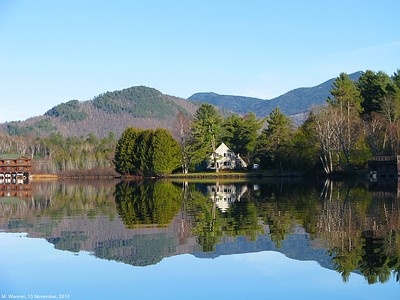 The house just right of center was the site of the old hotel. The building at left is part of the Ampersand Bay Resort. In the background is Baker Mountain, at left, and McKenzie Mountain, at right
The house just right of center was the site of the old hotel. The building at left is part of the Ampersand Bay Resort. In the background is Baker Mountain, at left, and McKenzie Mountain, at right 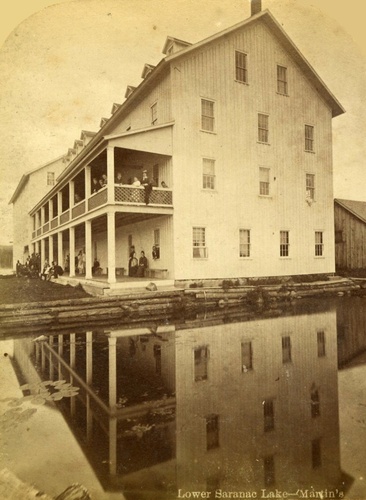 Martin's from a stereo view (undated) www.antiquephotographics.com
Martin's from a stereo view (undated) www.antiquephotographics.com 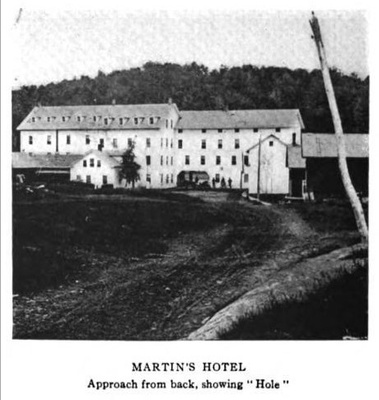
 The Saranac Lake House, universally called simply Martins (and later Miller's), was one of the most famous hotels in the Adirondacks in the latter half of the 19th century.
The Saranac Lake House, universally called simply Martins (and later Miller's), was one of the most famous hotels in the Adirondacks in the latter half of the 19th century.
The hotel was built by William F. Martin shortly after 1850 on Ampersand Bay on the northern shore of Lower Saranac Lake. Martin had started by leasing Pliny Miller's hotel in Saranac Lake in 1849 and 1850, where he quickly determined that a hotel designed to attract wealthy sportsmen would do well.
The hotel became famous for the congeniality of its host, the attractiveness of its setting, and, in part, for The Hole— an opening through the hotel through which the road to the lake passed. This came about as a result of joining buildings on either side of the road above the first floor level. The "look-through" was visible from a considerable distance as the building was approached, and guests looked forward to the sight after a long stagecoach ride from Ausable Forks. It was also a favorite lounging spot for guests and guides alike.
The hotel did well for itself, especially after its virtues were broadcast by appearing in W.H.H. Murray's Adventures in the Wilderness; or, Camp-Life in the Adirondacks. 1 Guests included U.S. President Theodore Roosevelt 2 and Vice President William A Wheeler.
The hotel was one of the early destinations for health seekers. Donaldson wrote in his two volume history of the Adirondacks "among the guests at Martins from as early as 1860 there were always a few who had TB, and went there for the relief they found." 3
Quoting from Wallace’s Guide to the Adirondacks, 1875, p. 114:
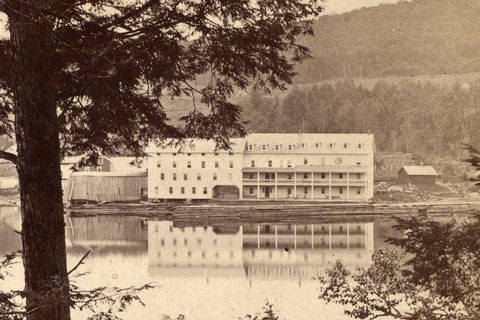 Martin's, Saranac Lake, from the west, 1865. Photo by S.R. Stoddard
Martin's, Saranac Lake, from the west, 1865. Photo by S.R. Stoddard
The Miriam and Ira D. Wallach Division of Art, Prints and Photographs:
Photography Collection, The New York Public Library.
The New York Public Library Digital Collections. "'Martin’s,' one of the far-famed gateways to the Wilderness, is a most desirable tarrying place for all in quest of health or sporting recreation. The house has recently been greatly enlarged and now affords apartments for 250 guests. The parlors are 64 ft. and the dining hall 84 ft. in length. The rooms are generally large and airy, and are furnished with taste and neatness, and while occupying them one may enjoy most of the comforts of the “St. Nicholas” or “Fifth Avenue,” together with all the rare and dainty viands the region yields, and at the same time command an exquisite view of the varied beauties that lake, mountain and forest ever give.
For the interest of ladies we will say that the fine croquet ground connected with the premises will afford them agreeable diversion when weary of boating. Stages arrive and depart daily and tri-weekly for Paul Smith’s, Hough’s, Point of Rocks, North Elba, Wilmington Notch, Keene, Elizabethtown and Westport, and mail and telephone communications are complete. Parties, including a goodly sprinkling of ladies, assemble here in large numbers during the summer months, some of whom make this their headquarters, while others proceed to Bartlett’s, Corey’s, Hough’s, Dugett’s, Kellogg’s, Cary’s, Moody’s and Graves’s, or to camp on some of the many delightful lakes or ponds that form a vast net-work in this romantic Wilderness. Martin furnishes the sportsman with a complete outfit, comprising boats, guides, tents, and all the requisites of camp life; as do also all the hotels above noted." 4
Despite the considerable success of the hotel, Martin lost it in 1881. He had a mortgage on the place held by a creditor who enjoyed the hotel, and was unconcerned about the past-due state of the payments. However, when he died suddenly, his son foreclosed on the loan immediately, selling the property to Milo B. Miller, who enclosed the famous hole to make a spacious office for himself. From that point, the hotel was known as Miller's.
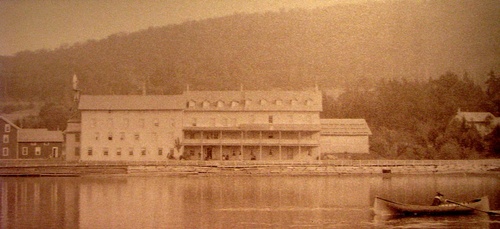 Miller's, c. 1880, missing the Hole (Adirondack Museum) In March 1888, the main section of the hotel was completely destroyed by fire. The remaining guide house, with about thirty bedrooms, was saved, and was run as a hotel for several years after until it, too burned to the ground in March, 1897.
Miller's, c. 1880, missing the Hole (Adirondack Museum) In March 1888, the main section of the hotel was completely destroyed by fire. The remaining guide house, with about thirty bedrooms, was saved, and was run as a hotel for several years after until it, too burned to the ground in March, 1897.
Sources
- Donaldson, Alfred L., A History of the Adirondacks, New York: The Century Co., 1921 (reprinted by Purple Mountain Press, Fleischmanns, NY, 1992)
- Wallace, Edwin R., Guide to the Adirondacks, The American News Company, 1875.
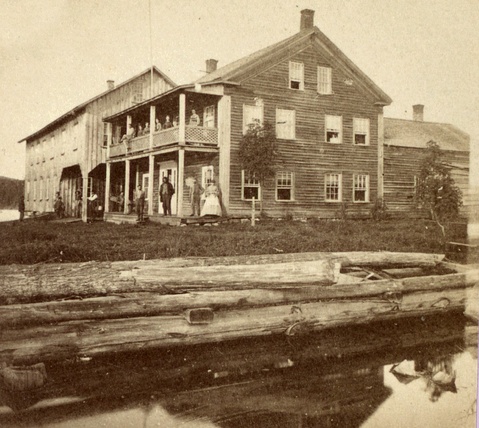 The Miriam and Ira D. Wallach Division of Art, Prints and Photographs: Photography Collection, The New York Public Library. (c. 1870). Martin's, Lower Saranac.
The Miriam and Ira D. Wallach Division of Art, Prints and Photographs: Photography Collection, The New York Public Library. (c. 1870). Martin's, Lower Saranac.
Retrieved from New York Public Library Digital CollectionsAdirondack Daily Enterprise, August 13, 1986
Wilderness hotel answered skeptics
The Saranac Lake House
Where Lake Street presently meets the shore of Lower Saranac Lake there once existed a fabulous hotel renowned for both its owner and its famous guests. It also played an important role in the history of our village.
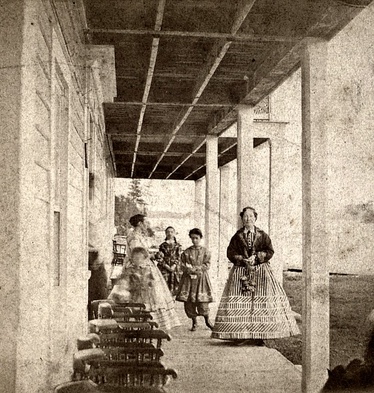 Martin's Piazza, 1865. Photo by H.S. Tousley
Martin's Piazza, 1865. Photo by H.S. Tousley
The Miriam and Ira D. Wallach Division of Art, Prints and Photographs: Photography Collection, The New York Public Library.
The New York Public Library Digital Collections. During the latter half of the 1800's the desk registers listed such prominent names as Teddy Roosevelt, Vice President, William Almon Wheeler and Governor Levi Morton. From the business world came Macy, Rockefeller, Tiffany, Winchester, Morganthau and McAlpin among many others. Authors and artists were represented by Henry Van Dyke, Street, Headley and "Adirondack" Murray together with W.J. Stillman and A.F. Tait. Names closely associated with the area: Paul Smith, Dr. E.L. Trudeau, S. R. Stoddard, Verplanck Colvin, W.W. Durant and Thomas Blagden appear with regularity through the pages. Many guests signed in with such renowned guides as Mitchell Sabattis, Alvah Dunning, Mart Moody, Steve Martin, Jesse Corey and John Plumley. Other guides arrived in their guide boats to pick up the patrons arriving by stage coach from AuSable Forks and Elizabethtown.
Its founder William F. Martin came to the village in 1849 when he leased the Pliny Miller Hotel for a period of one year. The lease was purposely brief because he had arrived with a definite plan formulated to engage in another enterprise as soon as possible. Even before Paul Smith, Martin recognized the potential for a successful hotel in the wilderness. After scouting around he found an ideal location on the southeast shore of Lower Saranac Lake.
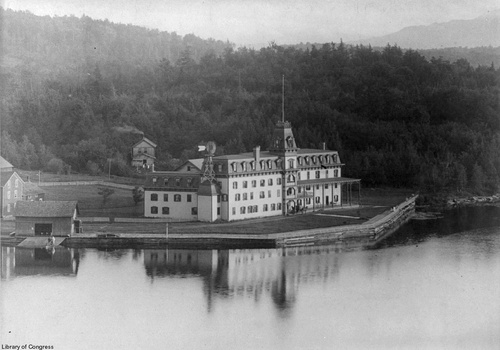 Saranac Lake House, c. 1890 From this vantage point the woods and waterways were immediately accessible to the sportsman. With his two brothers Martin began to raise a frame building on the site that could house 80 guests. All of the settlements of that era had small commercial hotels but this was the very first to be located in the wilderness. The locals thought for sure that Martin had only one oar in the water. Despite all the skepticism the place caught on and, as the word spread, his house was filled to capacity. Officially he had named his hotel "The Saranac Lake House" but it was popularly known as "Martin's."
Saranac Lake House, c. 1890 From this vantage point the woods and waterways were immediately accessible to the sportsman. With his two brothers Martin began to raise a frame building on the site that could house 80 guests. All of the settlements of that era had small commercial hotels but this was the very first to be located in the wilderness. The locals thought for sure that Martin had only one oar in the water. Despite all the skepticism the place caught on and, as the word spread, his house was filled to capacity. Officially he had named his hotel "The Saranac Lake House" but it was popularly known as "Martin's."
Three-and-a-half stories
Over the years he added to the original until the building reached three-and-a-half stories and contained 250 rooms. The house also boasted a set of bowling alleys, a billiard room and a croquet lawn in front of the main verandah. Whiskey went for 6 cents a glass, meals were 75 cents in the dining room and guides ate for 25 cents in the kitchen. In season the menu featured trout and venison and amazingly, without the benefit of refrigeration in those early days, oysters were a popular item.
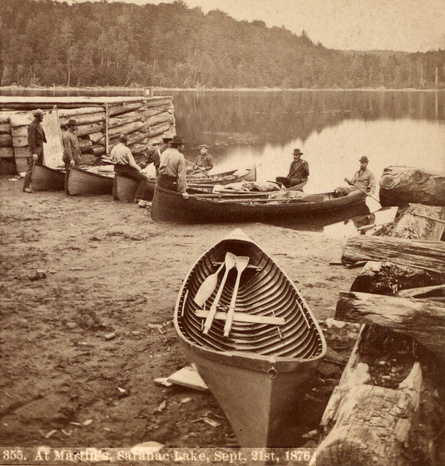 The Miriam and Ira D. Wallach Division of Art, Prints and Photographs: Photography Collection, The New York Public Library. "At Martin's, Saranac Lake, Sept. 28, 1878." The New York Public Library Digital Collections. prosperity to all Adirondack resorts as the escapees from conscription fled to the mountains to avoid military service. Paul Smith's and Martin's both had standing room only and right on the heels of the Civil War tide came "Murray's Rush." The Rev. William Henry Harrison Murray published a little book in 1869 titled ''Adventures in the Wilderness; or Camp Life in the Adirondacks'' which lavishly extolled the wonders of life in the woods and earned the author the coveted sobriquet of "Adirondack" Murray. His hunting and fishing tall tales, together with promises of improved health caused the greatest invasion of the northwoods ever witnessed by the resort hotels. Accommodations were stretched to the breaking point with some guests (or so the story goes) being forced to sleep on billiard tables. On a rainy summer day Martin returned from a fishing expedition to find his lobby overrun with a swarm of "Murray's Fools" loudly clamoring for rooms as his wife was attempting to' register them. Fortunately the fish had been very cooperative that day so baked lake trout was featured on the evening dinner menu.
The Miriam and Ira D. Wallach Division of Art, Prints and Photographs: Photography Collection, The New York Public Library. "At Martin's, Saranac Lake, Sept. 28, 1878." The New York Public Library Digital Collections. prosperity to all Adirondack resorts as the escapees from conscription fled to the mountains to avoid military service. Paul Smith's and Martin's both had standing room only and right on the heels of the Civil War tide came "Murray's Rush." The Rev. William Henry Harrison Murray published a little book in 1869 titled ''Adventures in the Wilderness; or Camp Life in the Adirondacks'' which lavishly extolled the wonders of life in the woods and earned the author the coveted sobriquet of "Adirondack" Murray. His hunting and fishing tall tales, together with promises of improved health caused the greatest invasion of the northwoods ever witnessed by the resort hotels. Accommodations were stretched to the breaking point with some guests (or so the story goes) being forced to sleep on billiard tables. On a rainy summer day Martin returned from a fishing expedition to find his lobby overrun with a swarm of "Murray's Fools" loudly clamoring for rooms as his wife was attempting to' register them. Fortunately the fish had been very cooperative that day so baked lake trout was featured on the evening dinner menu.
Built steamboat
Always seeking new means to please his clientele Martin decided to build a steamboat. His son, William Allen Martin, had already earned considerable fame as a builder of guide boats in his shop behind the hotel, and another boat builder by the name of Fred Rice had some steam engine experience. Between the two they somehow managed to construct a suitable craft which they christened the Water Lily. It became the first steamboat to cruise in Adirondack waters. When it made its inaugural trip in 1878, it had no less than John Phillip Sousa's band aboard to entertain the hotel guests. Obviously the little steamer became a popular novelty on the lake.
Trip to Bartlett's
To further the usefulness of his boat, Martin decided to carry passengers to Bartlett's Hotel on the carry between Upper and Middle Saranac Lakes. To accomplish this he had to build a dam and clear a channel at the present site of the upper locks. When all was ready, he scheduled regular trips between the two hotels which made the tourists very happy but the guides very unhappy. The loss of business was a sore spot among the guides who felt this was an invasion of their domain and a secret scheme was plotted to right the wrong. On a dark and stormy night a certain band of vigilantes dynamited the dam and business was back to normal.
Saranac evolves
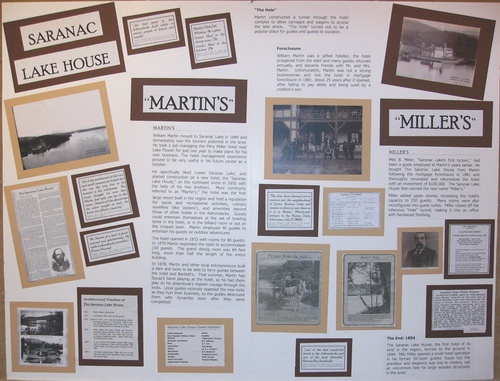 Martin's Display created by Karina Jackson, History Day 2008. Click on image to enlarge the display. The name Saranac had been applied to the three lakes, and also to the river which connected them, but had not as yet been applied to the village. The derivation of the word has baffled historians and Indian translators for ages.
Martin's Display created by Karina Jackson, History Day 2008. Click on image to enlarge the display. The name Saranac had been applied to the three lakes, and also to the river which connected them, but had not as yet been applied to the village. The derivation of the word has baffled historians and Indian translators for ages.
Did the name descend downstream from the lakes to the river or was it vice versa? At first it was believed to be an Indian name but William Beauchamp, in his authoritative "Aboriginal Place Names of New York," states that no meaning has been definitely assigned this name. In his history, A.L. Donaldson cites a possible solution to the mystery. The name St. Aranack is shown on an early map to designate a river and from the French pronunciation might have slurred it into Saranac. I'm inclined to agree with Donaldson.
 An 1878 list of camping supplies made by a Martin's patron.
An 1878 list of camping supplies made by a Martin's patron.
Courtesy of John J. Wheeler
The infant settlement on the river had been called "Harrietstown" and at an earlier date was known simply as "The River." Later movements attempted to name the village in honor of some of its prominent citizens. Among the nominees were "Baker's" for Col. Milote Baker, "Trudeau" for Dr. E.L. Trudeau and "Bloodville" for Orlando Blood. Col. Baker owned a hotel next to the present Pine Street bridge and in 1854 he became the hamlet's first postmaster. The colonel was a firebrand Democrat and when Buchanan lost to Lincoln in 1861, he not only lost his post office to Martin but also lost the opportunity to have his name immortalized in village history.
In 1866 Martin decided to relinquish the postal job as being too bothersome. However, after five years of tenure at the Saranac Lake House, the post office designation had been firmly established. And so it came to pass that when Chester Peck received his appointment from Washington, D.C. the order read in part "to act as postmaster at Saranac Lake, N.Y." When the village was incorporated in 1892, the board apparently decided that it was as good a name as any, and it has been Saranac Lake ever since.
Adirondack Daily Enterprise, December 8, 1990
Excerpted from Presidents, from first to last, in the Adirondacks
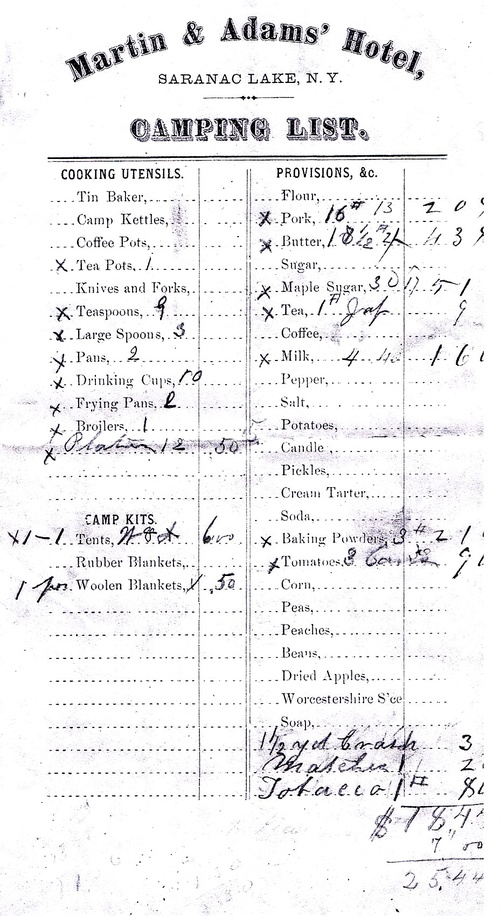 A pre-printed list of camping supplies from Martin's
A pre-printed list of camping supplies from Martin's
Courtesy of John J. Wheeler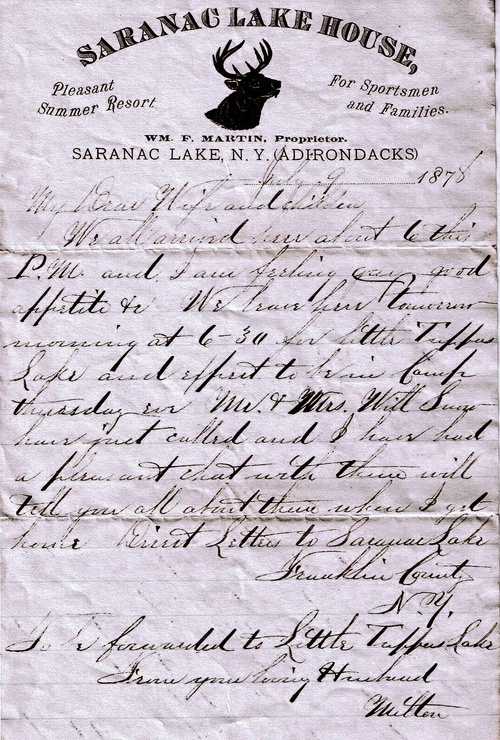 An 1878 letter from a patron of Martin's.
An 1878 letter from a patron of Martin's.
Courtesy of John J. WheelerMalone lawyer [and U.S. Vice President under Rutherford B. Hayes] William Almon Wheeler, who was born in Malone on June 30, 1819 […] was a frequent visitor to Saranac Lake where he stayed at Martin's Hotel on Lower Saranac Lake. William F. Martin was formerly from Bangor and he and the Vice President had been friends for many years. Wheeler served under [Ulysses S. Grant] in the House and authored the famous "Wheeler Compromise" which settled a long-standing debate over which legislature was legitimate in the State of Louisiana. After a brilliant career in politics, Wheeler returned to his home in Malone where he died on June 4, 1887.
Glens Falls Messenger, February 4, 1870
—'Saranac Lake is to be put in communication with the outside world by means of a telegraph line from Black Brook. The poles are already distributed from Martin's to Bloomingdale, and the line will be completed in early spring. But the item of most importance in this connection is, that the wire is to be made in Keeseville!—Essex Co. Republican
Potsdam Courier and Freeman, May 8, 1873
William F. Martin, proprietor of the Saranac Lake House, located on Lower Saranac Lake, in the southern part of Franklin county, is building an addition of fifty rooms to his already commodious house, making it by far the largest house in the Adirondac [sic] Wilderness.
New York Times, June 11, 1893
BEAUTIFUL SARANAC LAKE.
An Ideal Spot in Which to Spend the Hot Summer Months.
Saranac Lake, June 10.—This beautiful spot, with its peaceful waters, gentle, undulating vales, emerald forests, and surrounding lofty, pine-clad mountains, was never lovelier than now. Already the invasion of "summerers" has not only begun, but has continued for several weeks, and the various resorts are rapidly assuming a businesslike air.
…M. B. Miller will open the popular Saranac Lake House, under H. H. Tousley's management, June 15.
Dr. J. R. Romeyn, Keeseville, N. Y., has arrived. This is his forty-first year as a guest. Recent arrivals of New-Yorkers include George H. Cleaves. A. M. Church, Gardner Rand, R. M. Phelps, H. G. Rand, John Conley, Jr., and Edward J. Conley, also, Frederick J. Wells, Brooklyn, and Benjamin Douglass and F. L. Minton, Orange, N. J., members of the Saranac Club.
Mr. Miller has refurnished his house throughout and instituted many improvements, all of which add to the comfort and convenience of his guests.
An unidentified clipping from the Adirondack Collection, Saranac Lake Free Library, dated April 1894
WOOD TO ASHES: THE SARANAC LAKE HOUSE GONE IN SMOKE! Rain Prevents Further Damage.
The Oldest House in the Mountains--Proprietor M. B. Miller Away at the Time
Tuesday morning at ten minutes of three, Mrs. Bryant saw smoke and flame issuing from Miller's Saranac Lake House. At five o'clock a black pile of ashes and smoking ruins marked the spot where the oldest hotel in the woods once stood.
How the fire originated is a mystery. No theory can be made authentic, though the current opinion is that it was the work of some incendiary fiend. No one had been in the building for about two weeks.
Mr. Miller was in Plattsburgh, en route to Albany, at the time of the conflagration, and H. H. Tousley had just returned home. The house was beautifully furnished, but not even a chair was saved. The adjacent buildings escaped destruction by the heavy rain that was falling.
Not long ago Mr. Miller was offered a handsome sum for this property, but refused it. The loss will reach upwards of $75,000, insurance $28,750 with O'Neil and Hale; $18,500 was on the hotel; $9,950 on furniture and $300 on billiard tables.
Malone Farmer, October 10, 1900
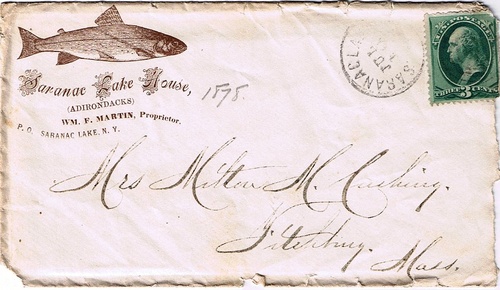 Courtesy of John J. WheelerThe Ampersand guide house at Saranac Lake, which has been called by the guides "Bull Frog Inn," together with the old Martin store, were destroyed by fire on Monday morning of last week, with their contents. The buildings were erected some 30 years ago by W. F. Martin, and have been in constant use ever since.
Courtesy of John J. WheelerThe Ampersand guide house at Saranac Lake, which has been called by the guides "Bull Frog Inn," together with the old Martin store, were destroyed by fire on Monday morning of last week, with their contents. The buildings were erected some 30 years ago by W. F. Martin, and have been in constant use ever since.
From an unidentified, undated news clipping from a scrapbook in the Saranac Lake Free Library.
MARTIN'S HOTEL CATERED TO SICK
Many Distinguished Guests at Famous Old Hotel for "the Trouble"
FIRST "SANITARIUM" OF KIND IT'S SAID
Widow of Former Founder and Proprietor Shows That Vicinity as Resort for Tuberculosis is Older by ten Years Than Supposed
That the Saranac Lake vicinity is several years older as a heath resort for the tuberculous than popularly supposed was shown positively by Mrs. E. E. Martin, widow of the proprietor of Martin's Hotel, who mentioned the names of several persons of greater or less note who came to the mountains for lung trouble and were guests for long periods at the hostelry.
John Colquitt, brother of Governor Colquitt of Texas, died of tuberculosis at Martin's Hotel in 1870 or perhaps earlier. He married Miss Sarah Whitehouse, a member of one of the best-known families in New York, whose brother had a handsome residence on Fifth avenue at the time. He stopped at the hotel with the single object of getting well. Not only did he spend two summers, but continued on into the winter of the second year he was in the Adirondacks when he died.
Mr. Colquitt was one of the last to visit the hotel for such a purpose and was preceded by among others Edgar Eddy [presumably Edward Edgar), a young man from one of the larger cities; John Merriam, a Virginian; a man member [sic] of the Rich family of New York; Dennis McMahon of New York, who went off later to California; and several others. "It strikes me that a lady in waiting to Queen Victoria, a Miss Murray I guess the name was, was also a sufferer from lung trouble," said Mrs. Martin. "She stopped at the house for quite a time."
Martin's Hotel was the first hotel as such in the vicinity of the Saranac Lakes. It even preceded Col. Milote Baker's by a couple of years, according to Mrs. Martin, who was book-keeper for the Colonel and acting postmistress for or a couple of years. Martin's was started in 1849 and finished the latter part of 1850. It occupied about the same site on the Lower Lake as the country club's summer house does now. Mr. Martin had previously rented old Captain Miller's house, which stood on the present site of the village office, and ran it as a boarding and lodging house for transients. Virgil Bartlett succeeded him there in the fall of 1850 when he started his new venture continuing until 1854 when the former opened the club house between the Middle and Upper Lakes still known as Bartlett's Carry.
Martin's Hotel was under the active control of Mr. Martin for 34 years and was without a rival in its day. The class of patronage which it enjoyed has been illustrated in the fore going.
Most of its guests of course came up to the Adirondacks to hunt and fish and it was common for a man to bring his entire family with him and spend the summer.
Plattsburgh Sentinel, April 1, 1870
THE NEW TELEGRAPH LINE.
—It seems that we were slightly misinformed in regard the route of the telegraph to the Saranac Lakes. But we are now enabled to speak definitely. It is to connect at Dannemora, instead of Black Brook, and run via Saranac, Redford, Clayburgh, Silver Lake, Franklin Falls, and Bloomingdale to Martin's (Lower Saranac,) and from thence to Paul Smith's. Offices will be established all of the points above named, unless it be Silver Lake. Officer Dow was over the entire route last week, and is pushing the work right ahead. He expects to have the line all up and in working order by the opening of the spring pleasure travel. This line will not only be of great convenience to tourists, but to the extensive business community, in the neighborhood of each office. We hope sometime to tee a railroad running along nearly the same route.
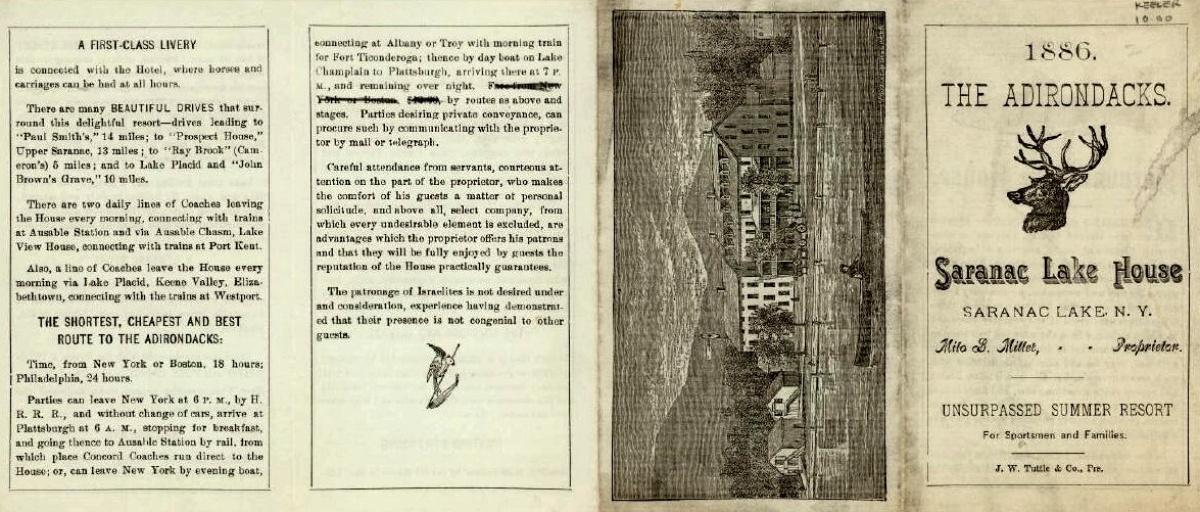 1886 Saranac Lake House brochure. Courtesy of the Adirondack Experience
1886 Saranac Lake House brochure. Courtesy of the Adirondack Experience
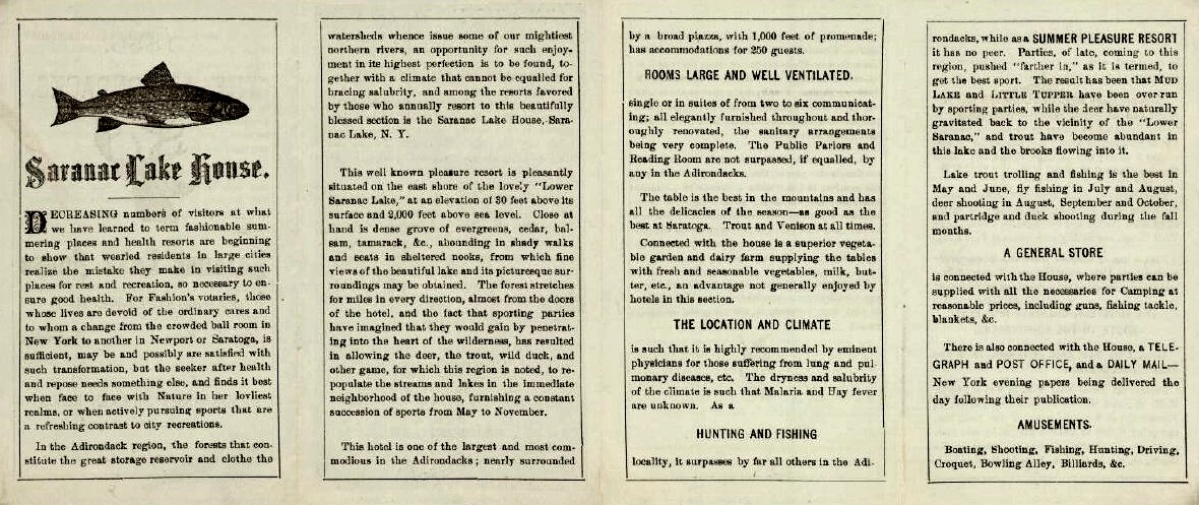 1886 Saranac Lake House brochure. Courtesy of the Adirondack Experience
1886 Saranac Lake House brochure. Courtesy of the Adirondack Experience
External link:
- The Adirondack Experience collection has an undated 12-page brochure giving the capacity as 300 guests and rates of $3 to $4 per day
Comments
Footnotes
1. Murray wrote: "It is located on Lower Saranac, at the terminus of the stage route from Keeseville. It is, therefore, the most convenient point at which to meet your guides. Its appointments are thorough and complete. Martin is one of the few men in the world who seem to know how to keep a hotel. At his house you can easily and cheaply obtain your entire outfit for a trip of any length. Here it is that the celebrated Long Lake guides, with their unrivalled boats, principally resort. Here, too, many of the Saranac guides, some of them surpassed by none, make their headquarters. Mr. Martin, as a host, is good-natured and gentlemanly. His table is abundantly provided, not only with the necessaries, but also with many of the luxuries, of diet. The charges are moderate, and the accommodations for families, as well as sporting parties, in every respect ample. "Martin's" is a favorite resort to all who have ever once visited it, and stands deservedly high in public estimation." In Donaldson, A History of the Adirondacks, pp. 292-3
2. Adirondack Daily Enterprise, December 8, 1990 "Presidents, from first to last, in the Adirondacks", John J. Duquette
3. Alfred L. Donaldson, A History of the Adirondacks, Vol. I, NY: The Century Co., 1921, 267.
4. Wallace’s Guide to the Adirondacks, 1875, p. 114.



